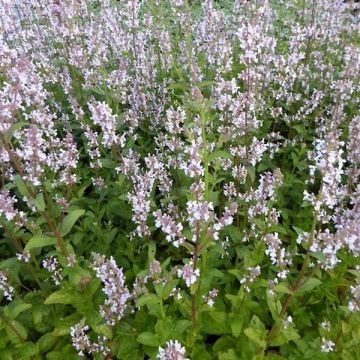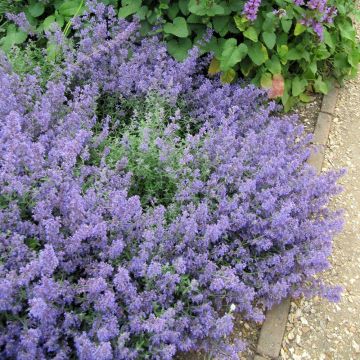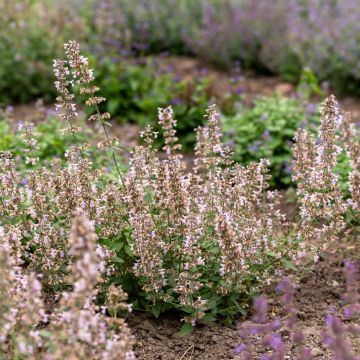

Nepeta subsessilis Dark Blue Panther - Catnip
Nepeta subsessilis Dark Blue Panther - Catnip
Nepeta subsessilis Dark Blue Panther
Japanese Catmint, Japanese Nepeta
This item cannot be shipped to the selected country
Dispatch by letter from €3.90
More information
Schedule delivery date,
and select date in basket
This plant carries a 6 months recovery warranty
More information
We guarantee the quality of our plants for a full growing cycle, and will replace at our expense any plant that fails to recover under normal climatic and planting conditions.
Seed-only orders are dispatched by sealed envelope. The delivery charge for seed-only orders is €3.90.
Does this plant fit my garden?
Set up your Plantfit profile →
Description
The Nepeta subsessilis 'Dark Blue Panther', also known as subsessile catmint, is a fast-flowering perennial with a bushy, erect, and well-branched habit, featuring broad light green aromatic leaves. Its dense and compact foliage forms a dome covered with large spikes of dark bluish-purple, wide, and fragrant flowers from the first summer. Preferring cool environments and heavy soils, the Nepeta subsessilis is ideal for borders, beds, or pots, thriving in sunny exposure. This variety starts flowering only 15 weeks after sowing.
The Nepeta subsessilis belongs to the Lamiaceae family. This perennial species is native to the moist mountain slopes of Asia. 'Dark Blue Panther' is a horticultural selection. The plant forms, from spring, a dense and bushy clump of 30 cm in height, spreading about 40 cm; it quickly spreads through its rhizomes. Flowering begins in June and continues until September. The flowers, clustered in dense spikes, are dark bluish-purple and measure 3 cm in length. Very melliferous, fragrant, they attract a large number of bees and butterflies. The foliage is medium green, and the leaves are very aromatic when crushed. They are ovate, toothed, glabrous, and measure 8 to 10 cm in length. It is one of the species most able to withstand high atmospheric humidity. Also known as Catmint, its leaves are attractive to these small felines.
The Nepeta subsessilis 'Dark Blue Panther' is an easy-to-grow plant, thriving ideally in cool, rich soil in sunny exposure. Although it tolerates dry, poor, and rocky soils, its flowering will be less generous in these conditions. Less drought-resistant than other Nepeta varieties, it, however, adapts better to heavy soils. Used in border plantings, on slopes, or in containers, the Nepeta subsessilis lends itself to charming combinations with roses to create a romantic atmosphere, or with perennials with yellow or orange flowers for a striking contrast, such as Achillea 'Terracotta', Coreopsis, or Rudbeckias. It also pairs very well with Lobelias and Chelone, and its bluish-purple flowering complements the intense blue of Salvia guaranitica. In heavy, moist soil, pair it with Salvia uliginosa with celestial blue flowers.
```Report an error about the product description
Flowering
Foliage
Plant habit
Botanical data
Nepeta
subsessilis
Dark Blue Panther
Lamiaceae
Japanese Catmint, Japanese Nepeta
Cultivar or hybrid
Other Nepeta - Catnip
Planting and care
Indoor Sowing
Sow Nepeta subsessilis Dark Blue Panther from spring to autumn in a moist potting mix, barely covering the seeds. Keep the compost surface moist but not waterlogged. Germination usually takes 7 to 21 days at 16-20 °C.
Once the young plants are sufficiently developed, transplant them into 7.5 cm pots or trays. Gradually acclimate the plants to cooler conditions for a few days before placing them outdoors, after all risk of frost, spacing them 30 cm apart. Choose a sunny location.
Direct Sowing
Sow in spring or early summer, after all risk of frost has passed.
Seeds can be sown outside directly where they are to flower. They can be sown thinly or in more formal beds and borders.
Sow seeds in short rows from March to May, at temperatures around 20°C. Lightly cover with soil.
Seeds will germinate in two to three weeks. Thin out the seedlings to 30 cm apart by early summer. Keep the compost slightly moist, but not constantly wet.
Sowing period
Intended location
This item has not been reviewed yet - be the first to leave a review about it.
Haven't found what you were looking for?
Hardiness is the lowest winter temperature a plant can endure without suffering serious damage or even dying. However, hardiness is affected by location (a sheltered area, such as a patio), protection (winter cover) and soil type (hardiness is improved by well-drained soil).

Photo Sharing Terms & Conditions
In order to encourage gardeners to interact and share their experiences, Promesse de fleurs offers various media enabling content to be uploaded onto its Site - in particular via the ‘Photo sharing’ module.
The User agrees to refrain from:
- Posting any content that is illegal, prejudicial, insulting, racist, inciteful to hatred, revisionist, contrary to public decency, that infringes on privacy or on the privacy rights of third parties, in particular the publicity rights of persons and goods, intellectual property rights, or the right to privacy.
- Submitting content on behalf of a third party;
- Impersonate the identity of a third party and/or publish any personal information about a third party;
In general, the User undertakes to refrain from any unethical behaviour.
All Content (in particular text, comments, files, images, photos, videos, creative works, etc.), which may be subject to property or intellectual property rights, image or other private rights, shall remain the property of the User, subject to the limited rights granted by the terms of the licence granted by Promesse de fleurs as stated below. Users are at liberty to publish or not to publish such Content on the Site, notably via the ‘Photo Sharing’ facility, and accept that this Content shall be made public and freely accessible, notably on the Internet.
Users further acknowledge, undertake to have ,and guarantee that they hold all necessary rights and permissions to publish such material on the Site, in particular with regard to the legislation in force pertaining to any privacy, property, intellectual property, image, or contractual rights, or rights of any other nature. By publishing such Content on the Site, Users acknowledge accepting full liability as publishers of the Content within the meaning of the law, and grant Promesse de fleurs, free of charge, an inclusive, worldwide licence for the said Content for the entire duration of its publication, including all reproduction, representation, up/downloading, displaying, performing, transmission, and storage rights.
Users also grant permission for their name to be linked to the Content and accept that this link may not always be made available.
By engaging in posting material, Users consent to their Content becoming automatically accessible on the Internet, in particular on other sites and/or blogs and/or web pages of the Promesse de fleurs site, including in particular social pages and the Promesse de fleurs catalogue.
Users may secure the removal of entrusted content free of charge by issuing a simple request via our contact form.
The flowering period indicated on our website applies to countries and regions located in USDA zone 8 (France, the United Kingdom, Ireland, the Netherlands, etc.)
It will vary according to where you live:
- In zones 9 to 10 (Italy, Spain, Greece, etc.), flowering will occur about 2 to 4 weeks earlier.
- In zones 6 to 7 (Germany, Poland, Slovenia, and lower mountainous regions), flowering will be delayed by 2 to 3 weeks.
- In zone 5 (Central Europe, Scandinavia), blooming will be delayed by 3 to 5 weeks.
In temperate climates, pruning of spring-flowering shrubs (forsythia, spireas, etc.) should be done just after flowering.
Pruning of summer-flowering shrubs (Indian Lilac, Perovskia, etc.) can be done in winter or spring.
In cold regions as well as with frost-sensitive plants, avoid pruning too early when severe frosts may still occur.
The planting period indicated on our website applies to countries and regions located in USDA zone 8 (France, United Kingdom, Ireland, Netherlands).
It will vary according to where you live:
- In Mediterranean zones (Marseille, Madrid, Milan, etc.), autumn and winter are the best planting periods.
- In continental zones (Strasbourg, Munich, Vienna, etc.), delay planting by 2 to 3 weeks in spring and bring it forward by 2 to 4 weeks in autumn.
- In mountainous regions (the Alps, Pyrenees, Carpathians, etc.), it is best to plant in late spring (May-June) or late summer (August-September).
The harvesting period indicated on our website applies to countries and regions in USDA zone 8 (France, England, Ireland, the Netherlands).
In colder areas (Scandinavia, Poland, Austria...) fruit and vegetable harvests are likely to be delayed by 3-4 weeks.
In warmer areas (Italy, Spain, Greece, etc.), harvesting will probably take place earlier, depending on weather conditions.
The sowing periods indicated on our website apply to countries and regions within USDA Zone 8 (France, UK, Ireland, Netherlands).
In colder areas (Scandinavia, Poland, Austria...), delay any outdoor sowing by 3-4 weeks, or sow under glass.
In warmer climes (Italy, Spain, Greece, etc.), bring outdoor sowing forward by a few weeks.














































